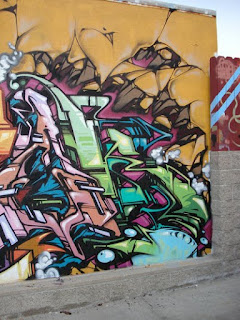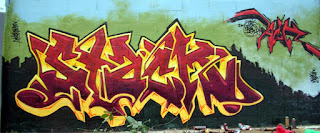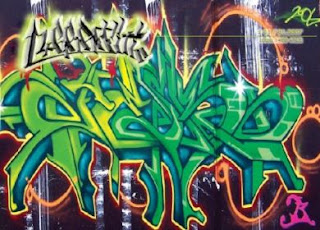When an artist reuses items in order to achieve a higher purpose in art, the final work is often captivating in a way that a two dimensional painting cannot be. Finding repeating patterns-like those in Hoke’s work-in installation and sculptural art links us not only to the material world, but also to the cellular processes of nature. Every piece has a function that helps with the biology of the overall system. There is something organic and fresh about it that makes this type of art fascinating.
Friday, October 22, 2010
The Gravity of Color
When an artist reuses items in order to achieve a higher purpose in art, the final work is often captivating in a way that a two dimensional painting cannot be. Finding repeating patterns-like those in Hoke’s work-in installation and sculptural art links us not only to the material world, but also to the cellular processes of nature. Every piece has a function that helps with the biology of the overall system. There is something organic and fresh about it that makes this type of art fascinating.
Friday Favorite Photo: Garage door
Wednesday, October 20, 2010
Left or right ?
"Yes." I replied. But as she switched lanes I realized I was wrong; I hadn't consulted my wrist.
I have a scar on the inside of my right wrist that tells me which is my right hand, and therefore which way is right. I apologized to my DIL and explained what was going on. "You don't know your right from your left?" she asked (sounding just a tad judgemental.) And I had to say yes, it's true, much to my shame and dismay.
 Just as some people make a writing motion to remember which is their right hand, I depend on my scar.
Just as some people make a writing motion to remember which is their right hand, I depend on my scar. I got the scar when I was seven and accidentally put my hand through a pane of glass. And because of my early dependence upon it, I never learned right from left. If someone asks me which way to go I just reflexively flip my wrist and look at the scar.
 I related this quirk to a friend a while back and she said, "But don't you have a sense of the right side of your body, and the left side of your body?"
I related this quirk to a friend a while back and she said, "But don't you have a sense of the right side of your body, and the left side of your body?"I'd never thought of it like that.
I'd always thought of right and left as being something "out there." Not as something that was a part of me.
So, in order to be better at telling left from right I've been looking down at myself lately and consciously thinking "here is my right" and "here is my left." I've been trying to get this idea ingrained in my sense of what's what. And it has been helping; I'm much better at telling right from left than I used to be, except when the pressure is on.
 It's just like math anxiety - which makes me unable to add 2 plus 2 if I'm under pressure to do so, or if someone is looking at me expectantly. My brain just refuses to concentrate in a situation like that. It's too busy thinking "Math - accckkkkkk!" to actually do any math.
It's just like math anxiety - which makes me unable to add 2 plus 2 if I'm under pressure to do so, or if someone is looking at me expectantly. My brain just refuses to concentrate in a situation like that. It's too busy thinking "Math - accckkkkkk!" to actually do any math.Same goes for right and left. If I'm nervous or on the spot I'll get flummoxed. There have been times when I've consulted my wrist and still couldn't tell right from left because I was too distracted with embarassment to remember which hand the scar was on!
 I spent a lot of time in community theater and always had a hard time knowing stage right from stage left. When I directed I had to keep a chart in front of me - a fact I kept hidden. My shameful little secret.
I spent a lot of time in community theater and always had a hard time knowing stage right from stage left. When I directed I had to keep a chart in front of me - a fact I kept hidden. My shameful little secret.How do you tell right from left? Is it something you just never have to think about, or do you have some little reminder? How did you learn it as a kid? This must have been something I missed out on.
Monday, October 18, 2010
Factory Girl
 I just recently read the tragic life story of Edie Sedgwick.
I just recently read the tragic life story of Edie Sedgwick.Told entirely by the recollections of those who knew her, Edie - American Girl, published in 1982, is a fascinating, though sad, portrait of the "swinging" 60s.

Aristrocratic and vivacious, Edie was the "it girl" of the 60s, photographed for Vogue and Life. She became Andy Warhol's companion and star of his underground movies.
She was also the subject of some of Bob Dylan's songs.
 It's sad to read about Edie's drug abuse and emotional instability. What a shame and what a waste.
It's sad to read about Edie's drug abuse and emotional instability. What a shame and what a waste.She was ruined by wealth and drugs and 15 minutes of fame. And when her 15 minutes were over there was no one to help her, or care for her - not her family, not a doctor, not a lover or a friend, and not even Warhol, who later claimed he hardly knew her.
Poor Edie. She died of an overdose at the age of 28. Her story is tragic, but it's a mesmerizing account of an extraordinary time.
Saturday, October 16, 2010
The best show on television
 The final episode of the fourth season of Mad Men will air tomorrow night and I'm already missing it. It's so unfair that television "seasons" are so short these days. Especially for shows as good as Mad Men. And especially for a season as good as this one has been.
The final episode of the fourth season of Mad Men will air tomorrow night and I'm already missing it. It's so unfair that television "seasons" are so short these days. Especially for shows as good as Mad Men. And especially for a season as good as this one has been.Mad Men proves how good television can be. Not only are the vintage sets, costumes, and props a treat, but the characters are compelling and the writing is top-notch. There were two episodes this season that just awed me with their brilliance - the one all about Peggy and Don, and the one all about the women.
 Watching the show you just know that some of the character's lives can't possibly turn out well, but you root for them anyway. You hope for them. And it's fun to know what's just around the corner for all of them, perched as they are in the middle of the 1960s. It might be called Mad Men, but the show has a lot to say about the lives of women in that time period, too.
Watching the show you just know that some of the character's lives can't possibly turn out well, but you root for them anyway. You hope for them. And it's fun to know what's just around the corner for all of them, perched as they are in the middle of the 1960s. It might be called Mad Men, but the show has a lot to say about the lives of women in that time period, too.Here's a cool little music video I found. It's a mash up of the Mad Men theme and "Nature Boy" (a song made famous by Nat King Cole.)
Wednesday, October 13, 2010
Alice Munro
 I recently finished reading Carried Away, a brilliant collection of short fiction by Alice Munro. It includes seventeen of her favorite stories from some of her earliest to her most recent, ending with "The Bear Came Over The Mountain" from which the movie Away From Her was made.
I recently finished reading Carried Away, a brilliant collection of short fiction by Alice Munro. It includes seventeen of her favorite stories from some of her earliest to her most recent, ending with "The Bear Came Over The Mountain" from which the movie Away From Her was made. I'd heard of Alice Munro, but hadn't read her stories until I got this book and now I'm a huge fan. I'm a little sorry it took so long for me to discover her, but better late than never I guess. Alice Munro has been described as one of the best fiction writers of our age, and I'd certaily have to agree with that. She's now my all time favorite writer.
 A Canadian, Alice writes about ordinary events in ordinary lives with amazing insight about human nature, and particulairly about the lives of women and girls.
A Canadian, Alice writes about ordinary events in ordinary lives with amazing insight about human nature, and particulairly about the lives of women and girls.
She's been writing since her twenties, publishing fourteen books of beautifully constructed stories, and is now 79 years old. "Memory is the way we keep telling ourselves our stories - and telling other people a somewhat different version of our stories." Alice Munro
"Memory is the way we keep telling ourselves our stories - and telling other people a somewhat different version of our stories." Alice Munro
Monday, October 11, 2010
Natalie




Thursday, October 7, 2010
Cool Clouds
Monday, October 4, 2010
Art Prize

This is "Vision" by David Spriggs of Montreal. It's one of the "Top Ten" of the competition. Made from sheets of Plexiglas that have been marked somehow to make this effect, it's different from every side and angle. I thought it was amazing.

This is a detail of "Dream Collection" by Heather Holloman. The Mason Jars hold objects pertinent to the dreams described on the tags. It was fascinating and I wished I would have spent more time looking at it and reading the tags, but it was crowded, my feet were hurting, and I just wanted to get somewhere to sit down for a few minutes. Darn.
 This is "Chroma Passage" by Janice Arnold. A hallway of the Grand Rapids Art Museum draped with handmade felt. I loved this.
This is "Chroma Passage" by Janice Arnold. A hallway of the Grand Rapids Art Museum draped with handmade felt. I loved this.

Detail of Svelata:

You'll find the Art Prize site at http://www.artprize.org/


























